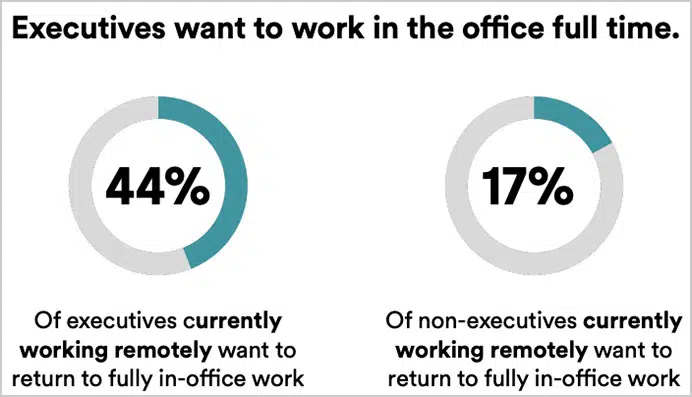As a facilities leader, you help the organization navigate change. These days, that remit could include returning to the office.
While this may seem straightforward, be prepared. Facilities management post-COVID will likely play a key role in retaining talent.
Hybrid or home-based work models took off with the pandemic, with research showing a sustained preference for flexibility.
Among workers whose jobs can be performed at home, three in five professionals continue to work from home, according to February data from the Pew Research Center.
Yet, in many workplaces, executive leaders want to entice workers back to the office. With your knowledge of facilities management post-COVID, you’ll be an important voice in that conversation.
There’s much at stake. The battle to retain talent, particularly at non-executive level, requires a strategy that recognizes fundamental concerns about health and safety. This is perhaps the most critical value-add you can bring to post-pandemic strategic planning.
- Only 17% of non-executives, currently working full-time remote, support a full-time return to the office.
- In comparison, 44% of executives in the same situation favor a full-time office return.
- Nearly 70% of CEOs are leading the return-to-office planning process, compared to just 3% of HR chiefs. This underscores a business-critical context.
So, how can you prepare for these conversations, and what actions should you recommend to the business?
From start to finish, keep the focus on health and safety. With that approach, you can help reassure employees of their safety, while fostering a more enjoyable workplace.
Discover three actions you can take to strengthen your organization’s return-to-office strategy.
1. Incorporate Smart Spaces into the Workplace
In the post-pandemic world, higher standards of health and safety must be seen and experienced. Smart spaces make this possible, and they can be incorporated at many touchpoints.
Let’s start with building controls. Smart technology adds greater levels of flexibility throughout the workplace, helping leaders flex up or down in response to fast-changing business needs.
“Smart technology for building controls is really essential,” says Tim Vanover, a 30-year veteran of the facility service industry and Director of Business Development at PRIDE Industries.
“If we have 40 people coming back to work tomorrow, how do we ramp up quickly, adjust airflows, and make sure their work environment is ready? Similarly, how do we communicate critical information with hundreds or thousands of people in real time?”
To address this challenge, facilities managers can communicate with the entire organization via work-order platforms. These platforms create triggers that send messages at scale.
“For example, you may want to communicate that the first two floors of a building have been sanitized,” says Randy Gregorcyk, Operations Director and Program Development Director at PRIDE Industries. “A work-order platform can send everyone an update via Teams, Slack, or another software stack.”
Timely, frequent communications play a vital role in boosting employee satisfaction.
2. Optimize for a Hybrid Work Model
More than 75% of companies have chosen to adopt a hybrid working model, according to research by Envoy, published in April. As such, facilities managers must be equipped to support the diverse needs of local and virtual workers, with people regularly switching between groups.
Always ensure that employees know what to expect before they get to the office. Providing sufficient information reduces anxiety and fosters a much-needed sense of structure and routine.
Desk-booking software can help. Colleagues can conveniently book space in advance, thanks to simple scheduling software. Known as office hoteling, organizations benefit by maximizing existing space on a day-to-day basis.
“Flexible office designs, paired with below-average occupancy, also allow for extra distance between workstations, as needed,” Gregorcyk says.
“And, with fewer workstations required, organizations can also achieve cost savings to the tune of about $8,000 per workstation, per year.”
You should also ask about how they have updated their methods, policies, or best practices, in light of the pandemic.
“Facility services leaders must always be able to respond quickly, keeping visitors and employees informed and comfortable... particularly when the goal is to entice workers back to the office.”
—Tim Vanover, a 30-year veteran of the facility service industry
3. Select Strategic Partners with Solid Records
Many organizations choose to outsource aspects of facilities management post-COVID. As part of this process, you should request information from possible vendors about their health and safety record.
You should also ask about how they have updated their methods, policies, or best practices, in light of the pandemic.
“All of these details can be used to evaluate potential partners. Shortlist vendors who show the ability to help your business level-up its own practices and procedures,” Vanover says.
Once you’ve identified key partners, communicate positive updates about each milestone that improves your organization’s performance. Work with your internal communications team, or PR department, to spread awareness. Encourage employees to celebrate shared successes.
The Bottom Line: Show Workers You Care, Every Day
As a facilities leader, you can help set a gold standard for trust between employee and employer.
Your ability to engage with and serve employees matters, particularly when designing plans for facility management post-COVID.
Whether it’s how quickly you resolve a complaint, or your ability to identify which parts of the building should be cleaned most frequently, these metrics send strong signals. They underscore that the office is a good place to work. It is consistently reliable, safe, and comfortable.
Now, how good is that?
Keep the message simple. Say it often. And back it up with proactive, reassuring actions.
Let's Talk Business
“By working together to implement new best practices, you can achieve significant improvements for health and safety.”
—Randy Gregorcyk, Operations Director and Program Development Director at PRIDE Industries
